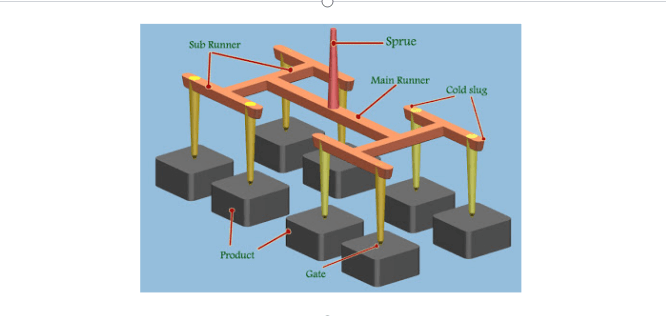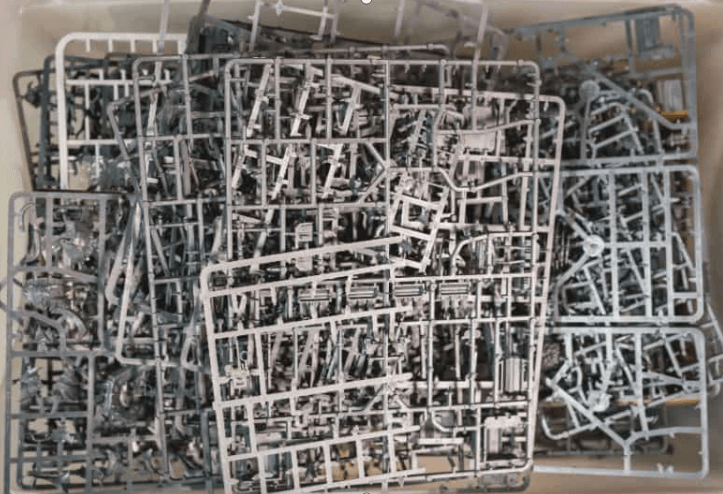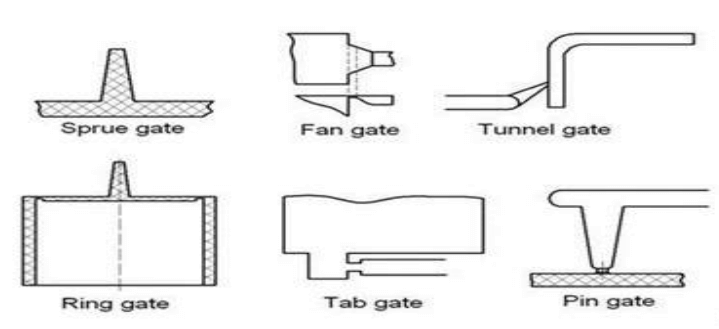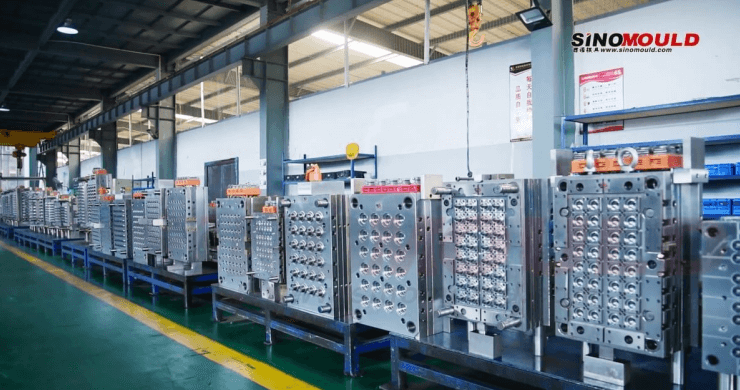

A sprue is a crucial element in the realm of plastic assembly. It serves as the entry point and vertical passage through which molten plastic flows into the mold. The sprue connects to runners and gates, ensuring a smooth and controlled distribution of the plastic within the mold cavities. This meticulous structure allows for the creation of intricate toy models and various pieces that form the end product. With the sprue's guidance, the connecting plastic assumes a well-defined structure, resulting in high-quality plastic assemblies.
In the realm of injection molding, the sprue plays a vital role in the overall system. It acts as a channel for the flows of molten plastic, directing it to the appropriate entry point within the mold. Through the vertical passage established by the sprue, the plastic navigates its way to the designated runners and gates. This system ensures efficient assembly and enables the production of precise parts and a flawless end product. By understanding the basics of sprues and their importance in the plastic assembly process, manufacturers can achieve optimal results and create well-structured plastic assemblies with ease.

Sprue in injection molding is a critical element with a defined purpose and notable significance. As an essential part of the casting system, the sprue acts as the entry point and vertical passage for molten plastic material from the Dakumar plastic injection molding machine. It connects directly to the mold cavity and plays a pivotal role throughout the entire assembly process. Functioning as a circular passageway, the sprue efficiently transports the liquid material to the designated cavities, ensuring a controlled and consistent flow. By tightly sealing the sprue, disassociation is prevented, and the high injection pressure is effectively limited. These design factors significantly influence the quality and effectiveness of the plasticating process, ultimately shaping the desired product's structure.
In the realm of injection molding, the sprue, also known as the runner, holds crucial importance. It forms an integral part of the system of runners, responsible for guiding the molten plastic material from the injection machine to the specific cavities within the mold. Carefully considered factors such as the sprue's length, cross-section, and pressure drop are paramount in optimizing the material flow and ensuring proper cavity filling. During the solidification stage, the sprue enables proportional cooling, promoting uniformity in the solidification process and minimizing the formation of defects. Additionally, the sprue acts as a conduit for the melt, preventing material loss and allowing for efficient utilization of the plasticating capacity. With its vital role in the injection molding process, the sprue significantly contributes to the overall efficiency and success of creating high-quality plastic assemblies.

Sprues play a versatile and essential role in the field of plastic injection molding. They are integral components that facilitate the transfer of molten plastic into molds, ensuring the proper formation of various components. EnviroTech Custom Injection Molders, renowned for their expertise, offers a wide range of services to cater to diverse needs. These services include standard injection molding, bulk injection molding, over-molding, and slab stock molding. With their custom plastic molding services, they cater to the requirements of both industrial and commercial clients. Their proficiency in handling hot plastic and their multiple locations provide reliable alternatives for achieving high-quality results.
Efficiently managing excess sprue material in injection molding is vital to minimize waste and optimize resources. Various sprue types and formats result in leftover plastic, which can be recycled and reused. By melting down the excess material, including sprues and runners, it can be reintroduced into future molds. Another approach involves using a chemical deglosser to dissolve the sprues, while the molten metal from the sprue can be recycled through a runner system or treated with a high-temperature flame from a blowtorch. These practices not only contribute to waste reduction but also promote sustainability in the injection molding process, ensuring efficient use of materials and resources.
In the realm of injection molding, the use of sprues is widely practiced to facilitate the production process. However, it is important to debunk the myth that sprues are always necessary. There are certain situations where their presence can be minimized or even eliminated altogether. For smaller production items or designs with simple sections, spot-level injection molding can be a viable alternative to using sprues. This method allows for a precise and controlled flow of molten plastic directly into specific locations without the need for sprues, runners, or gates. By bypassing the traditional sprue system, the production process becomes more streamlined and efficient.
In large-scale applications, where the format and working conditions permit, the absence of sprues can be seen. These scenarios often involve well-designed molds and processes that do not require the use of sprues. Instead, the molten plastic is distributed directly to the desired sections, resulting in a simplified and optimized production flow.
In the field of injection molding, various types of sprues are employed to ensure efficient material flow and distribution throughout the mold cavity.

Cold sprue bushings play a vital role in injection molding processes, contributing to enhanced efficiency and improved aesthetics. Positioned between the molding machine's nozzle and the mold cavity, these bushings create an unheated channel for the sprue. The dimensions of the cold sprue bushing, including the "O" dimension hole entrance and the circular radius, are carefully designed to ensure optimal material flow and alignment. By utilizing cold sprue bushings, manufacturers can streamline production by eliminating secondary operations such as trimming and removing the sprue, resulting in time and cost savings.
One of the key considerations when using cold sprue bushings is their impact on the appearance of the final product. The spherical radius at the nozzle end of the bushing plays a crucial role in achieving a smooth material flow and filling of the mold cavity. This contributes to improved aesthetics, ensuring that the molded parts have a high-quality finish. With the embedded cold sprue bushing in place, the focus shifts towards optimizing the molding process and achieving consistent results.
The use of cold sprue bushings provides several advantages in injection molding. By creating an unheated channel for the sprue, they eliminate the need for additional heating elements, reducing energy consumption. Moreover, the exclusion of heated runners and the simplified design contribute to increased efficiency and cost-effectiveness. Cold sprue bushings also offer the flexibility to easily remove the sprue from the final product without compromising the quality or integrity of the molded parts. These benefits make cold sprue bushings a valuable tool in enhancing efficiency and overall performance in injection molding processes.
Hot sprue bushings are essential components in injection molding, specifically designed to maintain the desired temperature within the hot passage. These bushings, which are inserted between the molding equipment's nozzles and the mold chamber, play a crucial role in providing heat to the resin melt. By utilizing a heat exchanger and a heating element, the hot sprue bushings create a controlled environment that ensures the resin remains in a molten state, ready for injection. This allows for efficient material flow and helps prevent premature solidification within the sprue, enabling smooth and consistent filling of the mold cavities.
The hot sprue bushings are carefully designed to contain and control the hot resin within the mold system. Their purpose is to keep the resin at the desired temperature, allowing it to flow smoothly from the sprue into the mold. With the hot passage maintained at an optimal temperature, the molten resin remains in its liquid state, ensuring efficient injection molding operations. The utilization of hot sprue bushings guarantees that the resin stays hot and ready for the molding process, enabling precise and high-quality results throughout the production cycle.
Sprue bushings play a crucial role in injection molding, particularly in optimizing material flow and enhancing production efficiency. The design of sprue bushings involves careful consideration of various factors, including dimensions, such as circular radius, entrance hole, and gate radius, as well as the surface features. The selection of the appropriate sprue bushings, whether flat-type or with a brushing head, depends on the specific requirements of the mold, injection machines, and space constraints. By choosing the right sprue bushings, manufacturers can ensure smooth resin flow, minimize tension and overflow, and achieve optimal results in the injection process.
The inner hole diameter, nozzle hole diameter, and overall length of the sprue bushings are critical elements in their design. The choice of the right dimensions is vital to accommodate the molten plastic material and facilitate its controlled flow from the nozzle into the mold cavity. The nozzle's diameter and inner hole angle also play a significant role in optimizing material distribution and achieving desirable results in terms of part quality and appearance. Additionally, the thickness of the mold plate and the sprue itself, along with efficient cooling, are important considerations that impact the overall performance and turnaround time of the injection molding processa.
When designing sprue bushings, manufacturers should carefully check catalogs and consult with providers to select the most suitable options for their specific requirements. It is important to consider factors such as mold design, resin properties, and desired cooling efficiency. By choosing the appropriate sprue bushings, manufacturers can streamline the injection molding process, shorten cycle times, and improve overall productivity and quality.

Choosing the right sprue is crucial in the injection molding process Dakumar to ensure optimal results and product quality. Several factors, such as the size, thickness, and diameter of the sprue, along with the material and tolerances of the mold, play a significant role in the selection process. is such an industry in the world of molding. Where he specializes in all these things. Factors like clamping force, feed characteristics, and the type of casting materials also impact the choice of the sprue.
The choice of sprue material is another essential consideration. Different materials, such as ABS or nylon, may be suitable depending on the specific needs of the product and the molding process. The opening and design of the sprue, as well as the number and size of the cavities in the mold, should be carefully evaluated to achieve the desired outcome. When selecting a sprue, it is essential to rely on a trusted manufacturer or supplier with expertise in custom injection molding. EnviroTech Custom Injection Molders, for example, is a reliable option known for providing high-quality sprues that are designed and manufactured to meet specific requirements.
By carefully considering these factors and relying on trusted suppliers, manufacturers can make informed decisions when selecting the right sprue for their injection molding projects. This ensures efficient production processes, reliable results, and ultimately, the successful realization of the desired product.
An example of sprue is a pathway or channel, such as in manufacturing processes, through which a liquid substance (like polystyrene or polyvinyl chloride) flows into a die. The liquid substance then cools down and solidifies within the die, ultimately forming various components.
The two types of intestinal sprue are tropical sprue and nontropical sprue. These are considered as distinct disease entities that were described in the 1880s. They exhibit similar morphological features, including varying degrees of villus atrophy of the small intestinal mucosa. Clinically, both types of sprue present with malabsorption symptoms.
